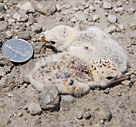 Luminant’s Big Brown Mine is currently welcoming its regular spring visitors. Just last week, the first interior least terns of the season appeared on site 15 years after they were initially spotted nesting at the mine. Listed by the U.S. Fish and Wildlife Service and the Texas Parks and Wildlife Department as endangered species, the terns (sterna antillarum athalassos) decided to take up roost in 1997 and have made Big Brown Mine their new home ever since.
Luminant’s Big Brown Mine is currently welcoming its regular spring visitors. Just last week, the first interior least terns of the season appeared on site 15 years after they were initially spotted nesting at the mine. Listed by the U.S. Fish and Wildlife Service and the Texas Parks and Wildlife Department as endangered species, the terns (sterna antillarum athalassos) decided to take up roost in 1997 and have made Big Brown Mine their new home ever since.
“Because terns generally nest in bare, sandy, open areas, Big Brown’s terrain and landscape is an ideal habitat for the species,” said Heath Martin, Luminant environmental supervisor. “To help rehabilitate them, we brought together a team of regulatory agency experts to develop a five-year management plan. Since breaking ground on this conservation effort, the terns have nested at Big Brown Mine nearly every year and we’ve seen populations increase significantly.”
Big Brown Mine environmental specialists have recorded more than 300 nests which have successfully raised more than 200 fledglings since 1997. The terns have even increased their habitat coverage, with additional nesting sites at Luminant’s Turlington and Kosse mines.
“To help these birds thrive and create permanent nesting sites, the primary objective of the plan was to increase their forage habitat,” said Maggie Bonds, Luminant environmental specialist. “Through our conservation efforts, we’ve seen this species begin to flourish and we’re hopeful that with increased environmental awareness the terns will eventually be freed from their endangered species status.”
A number of endangered, threatened and protected species, including the interior least tern, bald eagle, timber rattlesnake and alligator snapping turtle, as well as an abundance of other wildlife, benefit from Luminant’s restored mined lands and reservoirs.
